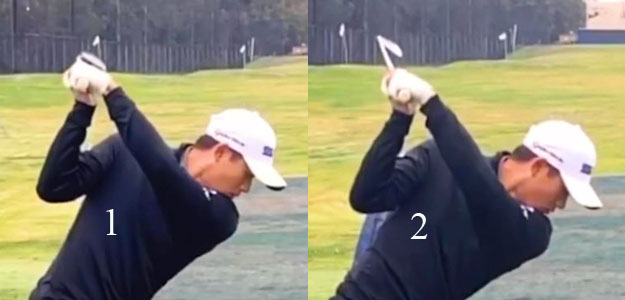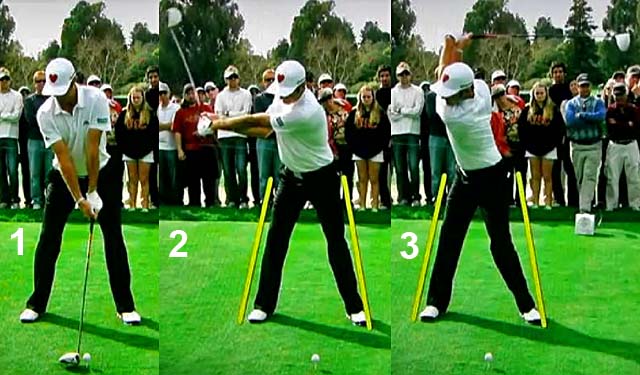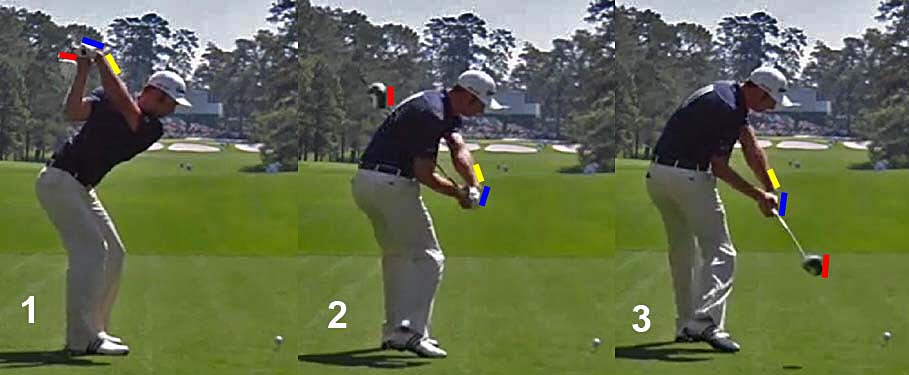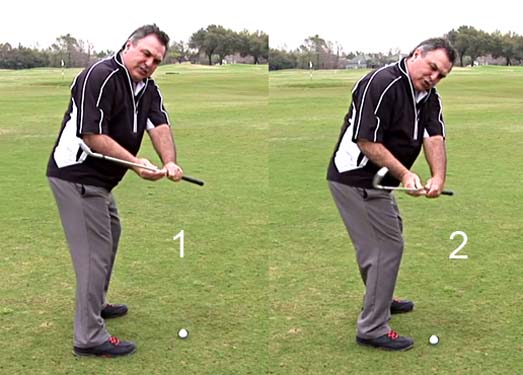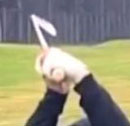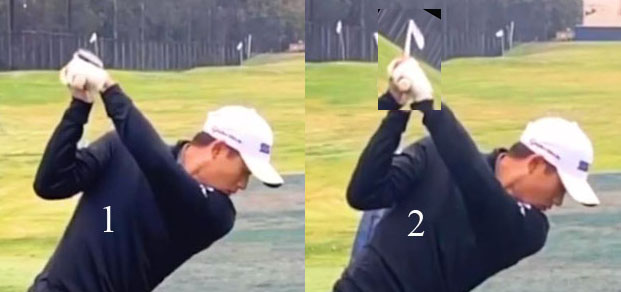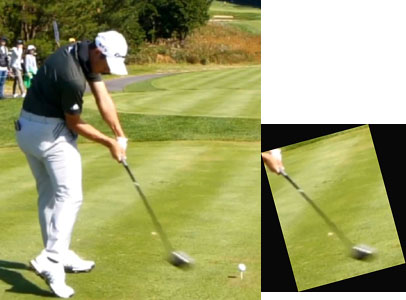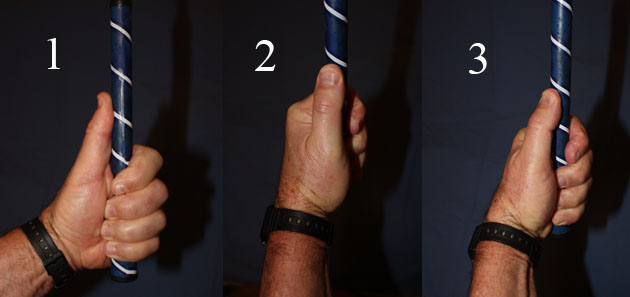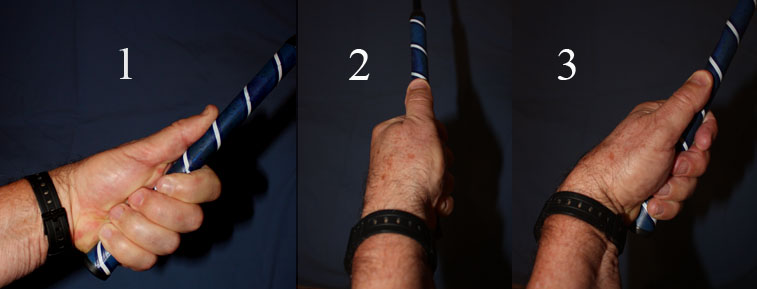In my last post, I noted that Jon Sinclair demonstrated that if he bowed his lead wrist when his lead wrist was radially deviated that he could get ~40 degrees of clubface closing with very little clubshaft angulation, and that if bowed his lead wrist when his lead wrist was ulnar deviated that he could get a lot of clubshaft angulation and a small amount of clubface closing. I decided to see if I could duplicate his findings by performing the following simple experiment.
I adopted a weak neutral lead hand grip where I placed my thumb down the shaft and I also used a low palmar lead hand grip.
I then radially deviated my lead wrist to get my clubshaft pointing towards the ceiling with my clubshaft being vertical (as Brian M described). Image 1 shows a side-view image of my lead wrist. Note that my 3rd, 4th and 5th fingers become roughly perpendicular to the club handle when my lead wrist is radially deviated.
Image 2 is a birds-eye viewing image looking down at my grip. Note that I have a weak (one knuckle) lead hand grip and note that I have placed my lead thumb on the top of the shaft. By looking at my thumb nail, I can roughly determine whether the clubshaft will rotate when I bow my lead wrist - by seeing whether my thumb nail rotates clockwise.
Image 3 depicts what happens when I bow my lead wrist. Note that the clubshaft remains nearly vertical and that there is no/very little clubshaft angulation. Note that my thumb nail rotates clockwise as the clubshaft rotates about its longitudinal axis, but my lead thumb remains roughly vertical.
Note that my lead forearm supinates to a small degree and that is because I was using my right hand to operate the camera and I could not use it to stabilise my lead lower forearm just above the lead wrist joint level. After taking the photograph, I repeated the lead wrist bowing maneuver while stabilising my lead lower forearm with my right hand to prevent any forearm supinatory motion - and I found the results to be identical.
What I am demonstrating is that "pure" lead wrist bowing (in the absence of a twistaway maneuver or lead wrist circumduction) closes the clubface by rotating the clubshaft around its longitudinal axis and it does not produce any clubshaft angulation (or very little clubshaft angulation) - if the lead wrist is radially deviated.
I then repeated the lead wrist bowing maneuver when the lead wrist is ulnar-deviated.
Image 1 shows that I have adopted a weak lead hand grip where the club handle is in a low palmar positional alignment. Note that my lead wrist is ulnar deviated. Note that the clubshaft is not perpendicular to my lead forearm and it is slanted by an amount that is compatible with a low palmar grip alignment (producing a moderate-sized accumulator #3 angle). Note that my 4th and 5th fingers are roughly perpendicular to the club handle while my 2nd and 3rd fingers are more angled relative to the club handle.
Image 2 is a birds-eye viewing image looking down at my grip. Note that I have a weak (one knuckle) lead hand grip and my lead thumb is placed on top of the club handle. Note that the club handle is perpendicular to the image's side-borders.
Image 3 shows what happens when I bow my lead wrist. Note that my clubshaft angulates a lot to the right (away from the target) and that there is no clubshaft rotation that causes my lead thumb nail to rotate clockwise.
Note that my lead forearm supinates because I could not use my right hand to stabilise my lead lower forearm just above lead wrist joint level. What effect could lead forearm supination theoretically produce during this lead wrist bowing maneuver? It could theoretically cause clubface closing during the lead wrist bowing demonstration, but that did not happen in this demonstration. After taking the photograph, I repeated the lead wrist bowing phenomenon while using my right hand to stabilise my lead lower forearm just above the level of my lead wrist joint. The result was the same - the clubshaft angulated with no (or very little) clubshaft rotation in a clubface-closing direction.
What I am demonstrating is that "pure" lead wrist bowing (in the absence of a twisaway maneuver or lead wrist circumduction) produces a significant amount of clubshaft angulation with no (or very little) clubshaft rotation in a clubface-closing direction - if the lead wrist is ulnar deviated.
Why did Jon Sinclair get 13 degrees of clubshaft rotation in a clubface closing direction in his demonstration?
Here are capture images of JS's demonstration.
Note that lead wrist bowing causes a lot of clubshaft angulation (away from the target) when the lead wrist is ulnar deviated.
Note that the clubface is closing very slightly during this demonstration. Why? My theory is that JS is unintentionally circumducting his lead wrist to a small degree while he bows his lead wrist by allowing his lead hand to move slightly more in an ulnar direction while his lead wrist bows. To test this hypothesis, I performed this demonstration many times and I found that it is more easily possible to produce lead wrist circumduction in an ulnar direction under the following conditions - i) if the degree of ulnar deviation is exaggerated or ii) if the 4th and 5th fingers apply too much finger-torquing action (in a twistaway manner) during the lead wrist bowing maneuver.
I recommend that you personally perform this "lead wrist bowing maneuver when the lead wrist is ulnar deviated" demonstration at home, and see whether you can produce significant clubshaft angulation with no (or very little) clubshaft rotation around its longitudinal axis in a clubface closing direction.
What did I learn from this experiment?
I have learned two fundamental biomechanical facts.
1) "Pure" lead wrist bowing (in the absence of a twistaway maneuver or lead wrist circumduction) closes the clubface by rotating the clubshaft around its longitudinal axis and it does not produce any clubshaft angulation (or very little clubshaft angulation) - if the lead wrist is radially deviated.
2) "Pure" lead wrist bowing (in the absence of a twisaway maneuver or lead wrist circumduction) produces a significant amount of clubshaft angulation with no (or very little) clubshaft rotation in a clubface-closing direction - if the lead wrist is ulnar deviated.
These two fundamental biomechanical principles, if correct, would predict the following phenomena in a pro golfer who uses a bowed lead wrist technique during the P4 => P7 time period.
i) Pro golfers, who use the bowed wrist technique where the lead wrist is already bowed by P4 and who keep the lead wrist continuously bowed between P4 -> P5.5 (while the lead wrist remains radially deviated), should have clubface closing due to clubshaft rotation in rough proportion to their degree of lead wrist bowing.
ii) Pro golfers, who keep their lead wrist bowed to a significant degree between P6 => P7 (while the lead wrist becomes increasingly ulnar-deviated) should show evidence of clubshaft angulation that creates a lot of forward shaft lean (but with no additional clubshaft rotation in a clubface closing direction) in the later downswing.
To test whether my hypothesis is true, I will analyse the swings of a number of pro golfers (who use the bowed lead wrist technique) in a series of future posts.
Jeff.
